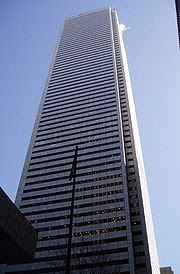
Banking in Canada is one of the most efficient and safest banking systems in the world,[1] ranking as the world's soundest banking system according to a 2008 World Economic Forum report.[2] According to the Department of Finance, Canada’s banks, also called chartered banks, have over 8,000 branches and almost 18,000 automated banking machines (ABMs) across the country.[3] In addition, "Canada has the highest number of ABMs per capita in the world and benefits from the highest penetration levels of electronic channels such as debit cards, Internet banking and telephone banking".
In everyday commerce, the banks in Canada are generally referred to in two categories: 1) the five large national banks and 2) smaller second tier banks (notwithstanding that a large national bank and a smaller second tier bank may share the same legal status and regulatory classification - see Safety and Soundness below.)
The five largest banks in Canada are the Royal Bank of Canada, the Toronto Dominion Bank, the Bank of Montreal, the Bank of Nova Scotia, and the Canadian Imperial Bank of Commerce. Notable second tier banks include the National Bank of Canada, the Mouvement Desjardins (technically not a bank but an alliance of credit unions), HSBC Bank Canada, and ING Bank of Canada. These second tier organizations are largely Canadian domestic banking organizations. Insurance companies in Canada have also created deposit-taking bank subsidiaries. For a complete list of institutions see: List of banks in Canada
FOR MORE VISIT--http://laws.justice.gc.ca/en/notice/index.html?redirect=%2Fen%2FB-1.01%2Findex.html
http://www.osfi-bsif.gc.ca/



No comments:
Post a Comment